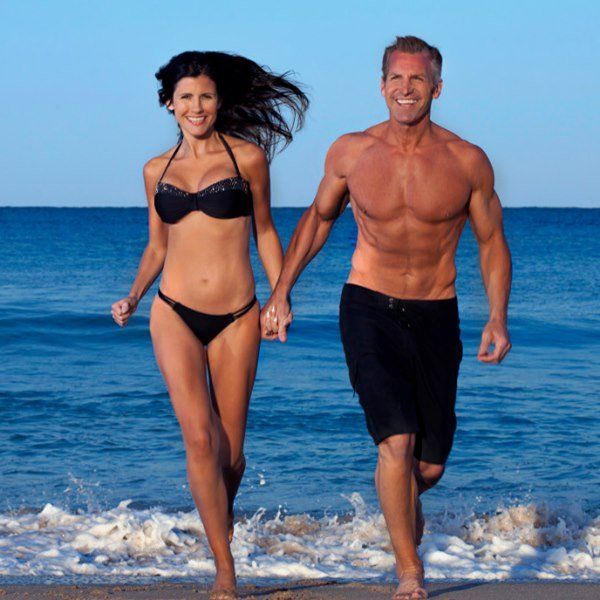What is FREE Testosterone?
Free Testosterone, or Bio-Available Testosterone is the unbound androgen circulating in a man's body that is bio-actively available for use by the cells and tissues.
Bound testosterone, on the other hand, is not biologically available or "bio-active", and is not included in the Free Testosterone level when measuring male sex hormone levels. Most Testosterone Serum Blood Tests measure both the Total and Free androgen levels.
When testing for Testosterone Deficiency in the lab, the measure that is most important is the Free Testosterone level vs the Total Testosterone level. A man can have apparently normal T levels, yet have Low T Symptoms. This occurs because the Free or bio-available testosterone is lower than normal causing symptoms.
Testosterone is the major androgenic hormone or male sex hormone. It is responsible for the development of the male external genitalia and secondary sexual characteristics. In females, its main role is as an estrogen precursor. In both genders, it also exerts anabolic effects and influences behavior. Importantly, Testosterone is the hormone of sexual desire in both sexes.
In men, testosterone is secreted by the testicular Leydig cells and, to a minor extent, by the adrenal cortex. In premenopausal women, the ovaries are the main source of testosterone with minor contributions by the adrenals and peripheral tissues. After menopause, ovarian testosterone production is significantly diminished. Testosterone production in testes and ovaries is regulated via pituitary-gonadal feedback involving luteinizing hormone (LH) and, to a lesser degree, inhibins and activins.
The amount of Free Testosterone circulating is about 2%, while the remaining androgen comprises the other 98%. While the bio-active or unbound quantity seems so small, testosterone is such a powerful anabolic steroid hormone that even this small % has such a great impact on a man's health.
Why so little Free Testosterone? Most circulating testosterone is bound to sex hormone-binding globulin (SHBG) a protein, which in men also is also called testosterone-binding globulin. As men age, a natural increase in SHBG binding proteins means less active or Free testosterone is circulating in the blood stream which can lead to symptoms of Low T, and also ED - Erectile Dysfunction (when caused by a testosterone deficiency).
Some testosterone physicians break down the remaining 98% into two types of bound androgen. Bio-available but bound and non-bioavailable and bound. The lesser fraction around 30%, is albumin-protein bound. Originally, it was thought that only the free testosterone part was thought to be the biologically active component. However, the bio-available but bound testosterone is weakly bound to the serum albumin and dissociates freely in the capillary bed, thereby becoming readily available for tissues and cell to use. For this reason, all non-SHBG-bound testosterone is considered to be bioavailable.
During childhood, excessive production of testosterone induces premature puberty in boys and masculinization in girls. In adult women, excess testosterone production results in varying degrees of virilization, including hirsutism, acne, oligo-amenorrhea, or infertility. Mild-to-moderate testosterone elevations are usually asymptomatic in males, but can cause distressing symptoms in females.
Bound testosterone, on the other hand, is not biologically available or "bio-active", and is not included in the Free Testosterone level when measuring male sex hormone levels. Most Testosterone Serum Blood Tests measure both the Total and Free androgen levels.
When testing for Testosterone Deficiency in the lab, the measure that is most important is the Free Testosterone level vs the Total Testosterone level. A man can have apparently normal T levels, yet have Low T Symptoms. This occurs because the Free or bio-available testosterone is lower than normal causing symptoms.
Testosterone is the major androgenic hormone or male sex hormone. It is responsible for the development of the male external genitalia and secondary sexual characteristics. In females, its main role is as an estrogen precursor. In both genders, it also exerts anabolic effects and influences behavior. Importantly, Testosterone is the hormone of sexual desire in both sexes.
In men, testosterone is secreted by the testicular Leydig cells and, to a minor extent, by the adrenal cortex. In premenopausal women, the ovaries are the main source of testosterone with minor contributions by the adrenals and peripheral tissues. After menopause, ovarian testosterone production is significantly diminished. Testosterone production in testes and ovaries is regulated via pituitary-gonadal feedback involving luteinizing hormone (LH) and, to a lesser degree, inhibins and activins.
The amount of Free Testosterone circulating is about 2%, while the remaining androgen comprises the other 98%. While the bio-active or unbound quantity seems so small, testosterone is such a powerful anabolic steroid hormone that even this small % has such a great impact on a man's health.
Why so little Free Testosterone? Most circulating testosterone is bound to sex hormone-binding globulin (SHBG) a protein, which in men also is also called testosterone-binding globulin. As men age, a natural increase in SHBG binding proteins means less active or Free testosterone is circulating in the blood stream which can lead to symptoms of Low T, and also ED - Erectile Dysfunction (when caused by a testosterone deficiency).
Some testosterone physicians break down the remaining 98% into two types of bound androgen. Bio-available but bound and non-bioavailable and bound. The lesser fraction around 30%, is albumin-protein bound. Originally, it was thought that only the free testosterone part was thought to be the biologically active component. However, the bio-available but bound testosterone is weakly bound to the serum albumin and dissociates freely in the capillary bed, thereby becoming readily available for tissues and cell to use. For this reason, all non-SHBG-bound testosterone is considered to be bioavailable.
During childhood, excessive production of testosterone induces premature puberty in boys and masculinization in girls. In adult women, excess testosterone production results in varying degrees of virilization, including hirsutism, acne, oligo-amenorrhea, or infertility. Mild-to-moderate testosterone elevations are usually asymptomatic in males, but can cause distressing symptoms in females.
The exact causes for mild-to-moderate elevations in testosterone often remain unclear. Common causes of pronounced elevations of testosterone include genetic conditions (eg, congenital adrenal hyperplasia); adrenal, testicular, and ovarian tumors; and abuse of testosterone, anabolic steroids or gonadotrophins by athletes or bodybuilders.
Decreased testosterone in females causes subtle symptoms. These may include some decline in libido and nonspecific mood changes. In males, it results in partial or complete degrees of hypogonadism. This is characterized by changes in male secondary sexual characteristics and reproductive function. The cause is either primary or secondary/tertiary (pituitary/hypothalamic) testicular failure.
In middle-aged men, there also is a steady decline in testosterone production starting around 35 to 40 years of age. Since this is associated with a simultaneous increase of SHBG levels, bioavailable testosterone may decline more significantly than apparent total testosterone, causing nonspecific symptoms similar to those observed in testosterone deficient females. However, severe hypogonadism, consequent to aging alone, is rare.
Measurement of total testosterone (TTST / Testosterone, Total, Serum) is often sufficient for Low T diagnosis, particularly if it is combined with measurements of LH and follicle-stimulation hormone (FSH) (LH / Luteinizing Hormone [LH], Serum and FSH / Follicle-Stimulating Hormone [FSH], Serum). However, these tests may be insufficient for diagnosis of mild abnormalities of testosterone homeostasis, particularly if abnormalities in SHBG (SHBG / Sex Hormone Binding Globulin [SHBG], Serum) function or levels are present.
For diagnosing hypogonadism or Andropause or to qualify for a Testosterone Therapy Program,, additional measurements of free testosterone or bioavailable testosterone are recommended. A complete testosterone blood panel or Anti-Aging Men's Lab Panel which measures bioavailable testosterone (TTBS / Testosterone, Total and Bioavailable, Serum) is the preferred hormone panel assay for Erectile Dysfunction, Andropausal or Hypogonadism treatment considerations.
Decreased testosterone in females causes subtle symptoms. These may include some decline in libido and nonspecific mood changes. In males, it results in partial or complete degrees of hypogonadism. This is characterized by changes in male secondary sexual characteristics and reproductive function. The cause is either primary or secondary/tertiary (pituitary/hypothalamic) testicular failure.
In middle-aged men, there also is a steady decline in testosterone production starting around 35 to 40 years of age. Since this is associated with a simultaneous increase of SHBG levels, bioavailable testosterone may decline more significantly than apparent total testosterone, causing nonspecific symptoms similar to those observed in testosterone deficient females. However, severe hypogonadism, consequent to aging alone, is rare.
Measurement of total testosterone (TTST / Testosterone, Total, Serum) is often sufficient for Low T diagnosis, particularly if it is combined with measurements of LH and follicle-stimulation hormone (FSH) (LH / Luteinizing Hormone [LH], Serum and FSH / Follicle-Stimulating Hormone [FSH], Serum). However, these tests may be insufficient for diagnosis of mild abnormalities of testosterone homeostasis, particularly if abnormalities in SHBG (SHBG / Sex Hormone Binding Globulin [SHBG], Serum) function or levels are present.
For diagnosing hypogonadism or Andropause or to qualify for a Testosterone Therapy Program,, additional measurements of free testosterone or bioavailable testosterone are recommended. A complete testosterone blood panel or Anti-Aging Men's Lab Panel which measures bioavailable testosterone (TTBS / Testosterone, Total and Bioavailable, Serum) is the preferred hormone panel assay for Erectile Dysfunction, Andropausal or Hypogonadism treatment considerations.
If your Free Testosterone levels are low, you may require male hormone supplementation or replacement therapy. There are many good TRT Testosterone Replacement Programs
available that use natural or bio-identical forms of the male hormone for Male HRT.
What is free testosterone?
 Get More Info
Get More InfoFree testosterone is the unbound form of testosterone circulating in the body that is immediately bioavailable for use by your body.

